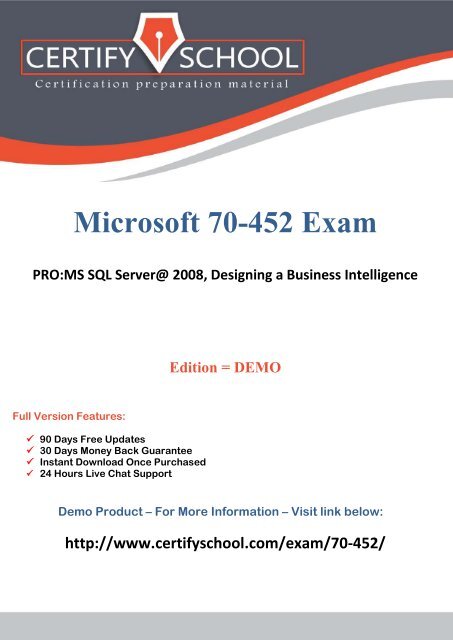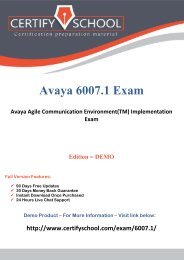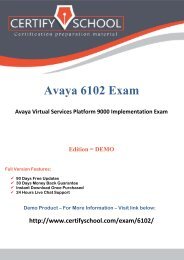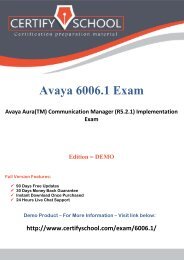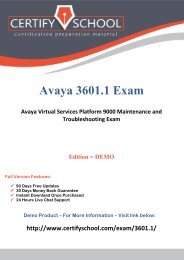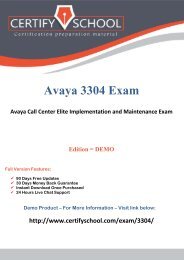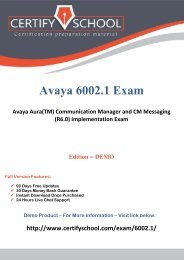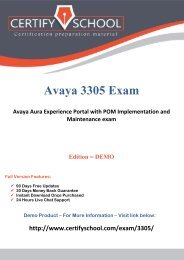70-452 Exam
For more Full product Details:www.CertifySchool.com Our workable study material for exam meets the exact and accurate exam questions and answers. So that’s why CertifySchool is popular in the field of IT Certification Exams material providers.Please visit site: www.CertifySchool.com/
For more Full product Details:www.CertifySchool.com
Our workable study material for exam meets the exact and accurate exam questions and answers. So that’s why CertifySchool is popular in the field of IT Certification Exams material providers.Please visit site: www.CertifySchool.com/
You also want an ePaper? Increase the reach of your titles
YUMPU automatically turns print PDFs into web optimized ePapers that Google loves.
www.CertifySchool.com Certification Preparation Material (PDF)<br />
Microsoft <strong>70</strong>-<strong>452</strong> <strong>Exam</strong><br />
PRO:MS SQL Server@ 2008, Designing a Business Intelligence<br />
Edition = DEMO<br />
Full Version Features:<br />
90 Days Free Updates<br />
30 Days Money Back Guarantee<br />
Instant Download Once Purchased<br />
24 Hours Live Chat Support<br />
Demo Product – For More Information – Visit link below:<br />
http://www.certifyschool.com/exam/<strong>70</strong>-<strong>452</strong>/<br />
http://www.certifyschool.com/exam/<strong>70</strong>-<strong>452</strong>/<br />
Page | 1
www.CertifySchool.com Certification Preparation Material (PDF)<br />
Question: 1.<br />
You design a Business Intelligence (BI) solution by using SQL Server 2008.<br />
You plan to create a SQL Server 2008 Reporting Services (SSRS) solution that contains five sales dashboard reports.<br />
Users must be able to manipulate the reports' parameters to analyze data.<br />
You need to ensure that the following requirements are met:<br />
Users can manipulate the parameters for data analysis in a single trip to the data source.<br />
Reports are automatically rendered as soon as they are accessed for the first time.<br />
Which two tasks should you perform (Each correct answer presents part of the solution. Choose two.)<br />
A. Filter data by using expressions.<br />
B. Specify the default values for each parameter.<br />
C. Create an available values list for each parameter.<br />
D. Create report parameters by using query parameters to filter data at the data source.<br />
Question: 2.<br />
Answer: AB<br />
You design a SQL Server 2008 Reporting Services (SSRS) solution. You create a report by using Microsoft Visual Studio<br />
.NET 2008.<br />
The report contains the following components:<br />
A dataset named Customer that lists all active customers and their details. The dataset accepts no parameters.A<br />
dataset named SalesHistory that lists all sales transactions for a specified time period and accepts year and month as<br />
parameters.You need to ensure that a summary of sales transactions is displayed for each customer after the<br />
customer details.<br />
Which component should you add to the report<br />
A. List<br />
B. Table<br />
C. Matrix<br />
D. Subreport<br />
Question: 3.<br />
Answer: D<br />
You design a Business Intelligence (BI) solution by using SQL Server 2008.<br />
The solution includes a SQL Server 2008 Analysis Services (SSAS) database. The database contains a data mining<br />
structure that uses a SQL Server 2008 table as a data source. A table named OrderDetails contains detailed<br />
information on product sales. The OrderDetails table includes a column named Markup.<br />
You build a data mining model by using the Microsoft Decision Trees algorithm. You classify Markup as discretized<br />
content. The algorithm produces a large number of branches for Markup and results in low confidence ratings on<br />
predictable columns. You need to verify whether the Markup values include inaccurate data. What should you do<br />
A. Modify the content type of Markup as Continuous.<br />
B. Create a data mining dimension in the SSAS database from OrderDetails.<br />
C. Create a data profile by using SQL Server 2008 Integration Services (SSIS).<br />
D. Create a cube in SSAS. Use OrderDetails as a measure group. Recreate the data mining structure and mining<br />
model from the cube data.<br />
http://www.certifyschool.com/exam/<strong>70</strong>-<strong>452</strong>/<br />
Page | 2
www.CertifySchool.com Certification Preparation Material (PDF)<br />
Question: 4.<br />
Answer: C<br />
You design a Business Intelligence (BI) solution by using SQL Server 2008.<br />
The solution contains a SQL Server 2008 Analysis Services (SSAS) database. A measure group in the database contains<br />
log entries of manufacturing events. These events include accidents, machine failures, production capacity metrics,<br />
and other activities.<br />
You need to implement a data mining model that meets the following requirements:<br />
Predict the frequency of different event types.<br />
Identify short-term and long-term patterns.<br />
Which algorithm should the data mining model use<br />
A. the Microsoft Time Series algorithm<br />
B. the Microsoft Decision Trees algorithm<br />
C. the Microsoft Linear Regression algorithm<br />
D. the Microsoft Logistic Regression algorithm<br />
Question: 5.<br />
Answer: A<br />
You design a Business Intelligence (BI) solution by using SQL Server 2008.<br />
The solution includes a SQL Server 2008 Analysis Services (SSAS) database. A cube in the database contains a large<br />
dimension named Customers. The database uses a data source that is located on a remote server.<br />
Each day, an application adds millions of fact rows and thousands of new customers. Currently, a full process of the<br />
cube takes several hours. You need to ensure that queries return the most recent customer data with the minimum<br />
amount of latency.<br />
Which cube storage model should you use<br />
A. hybrid online analytical processing (HOLAP)<br />
B. relational online analytical processing (ROLAP)<br />
C. multidimensional online analytical processing (MOLAP)<br />
D. automatic multidimensional online analytical processing (automatic MOLAP)<br />
Question: 6.<br />
Answer: A<br />
You design a Business Intelligence (BI) solution by using SQL Server 2008.<br />
The solution includes a SQL Server 2008 Analysis Services (SSAS) database. The database contains a cube named<br />
Financials. The cube contains objects as shown in the exhibit. (Click the Exhibit button.)<br />
http://www.certifyschool.com/exam/<strong>70</strong>-<strong>452</strong>/<br />
Page | 3
www.CertifySchool.com Certification Preparation Material (PDF)<br />
A calculated member named Gross Margin references both Sales Details and Product Costs.<br />
You need to ensure that the solution meets the following requirements:<br />
Managers must be able to view only their cost center’s percentage of the company’s gross margin.<br />
The impact on query performance is minimal.<br />
What should you do<br />
A. Add dimension-level security and enable the Visual Totals option.<br />
B. Add cell-level security that has read permissions on the Gross Margin measure<br />
C. Add cell-level security that has read contingent permissions on the Gross Margin measure.<br />
D. Change the permissions on the Managers dimension level from Read to Read/Write.<br />
Question: 7.<br />
Answer: A<br />
You design a Business Intelligence (BI) solution by using SQL Server 2008.<br />
The solution includes a SQL Server 2008 Reporting Services (SSRS) infrastructure in a scale-out deployment. All<br />
reports use a SQL Server 2008 relational database as the data source. You implement row-level security.<br />
You need to ensure that all reports display only the expected data based on the user who is viewing the report.<br />
What should you do<br />
A. Store the credential of a user in the data source.<br />
B. Configure the infrastructure to support Kerberos authentication.<br />
C. Configure the infrastructure to support anonymous authentication by using a custom authentication extension.<br />
D. Ensure that all report queries add a filter that uses the User.UserID value as a hidden parameter.<br />
Question: 8.<br />
Answer: B<br />
You design a Business Intelligence (BI) solution by using SQL Server 2008.<br />
You need to load data into your online transaction processing (OLTP) database once a week by using data from a flat<br />
file. The file contains all the details about new employees who joined your company last week. The data must be<br />
loaded into the tables shown in the exhibit. (Click the Exhibit button.) Employee.EmployeeID is an identity.<br />
http://www.certifyschool.com/exam/<strong>70</strong>-<strong>452</strong>/<br />
Page | 4
www.CertifySchool.com Certification Preparation Material (PDF)<br />
A SQL Server 2008 Integration Services (SSIS) package contains one data flow for each of the destination tables. In<br />
the Employee Data Flow, an OLE DB Command transformation executes a stored procedure that loads the Employee<br />
record and returns the EmployeeID value.<br />
You need to accomplish the following tasks:<br />
Ensure that the EmployeeID is used as a foreign key (FK) in all child tables for the correct Employee record.<br />
Minimize the number of round trips to the database.<br />
Ensure that the package performs in the most efficient manner possible.<br />
What should you do<br />
A. Use a Lookup Transformation in each of the child table data flows to find the EmployeeID based on first name and<br />
last name.<br />
B. Store the EmployeeID values in SSIS variables and use the variables to populate the FK columns in each of the child<br />
tables.<br />
C. After the Employee table is loaded, write the data to a Raw File Destination and use the raw file as a source for<br />
each of the subsequent Data Flows.<br />
D. After the Employee table is loaded, write the data to a Flat File Destination and use the flat file as a source for<br />
each of the subsequent Data Flows.<br />
Question: 9.<br />
Answer: C<br />
You design a Business Intelligence (BI) solution by using SQL Server 2008.<br />
You create a SQL Server 2008 Integration Services (SSIS) package to perform an extract, transform, and load (ETL)<br />
process to load data to a DimCustomer dimension table that contains 1 million rows.<br />
Your data flow uses the following components:<br />
A SQL Destination data flow task to insert new customers<br />
An OLE DB Command transform that updates existing customers<br />
On average, 25 percent of existing customer records is updated each night.<br />
You need to reduce the amount of time required to update customer records.<br />
What should you do<br />
A. Modify the UPDATE statement in the OLE DB Command transform to use the PAGLOCK table hint.<br />
http://www.certifyschool.com/exam/<strong>70</strong>-<strong>452</strong>/<br />
Page | 5
www.CertifySchool.com Certification Preparation Material (PDF)<br />
B. Modify the UPDATE statement in the OLE DB Command transform to use the TABLOCK table hint.<br />
C. Stage the data in the data flow. Replace the OLE DB Command transform in the data flow with an Execute SQL task<br />
in the control flow.<br />
D. Stage the data in the data flow. Replace the UPDATE statement in the OLE DB Command transform with a DELETE<br />
statement followed by an INSERT statement.<br />
Answer: C<br />
http://www.certifyschool.com/exam/<strong>70</strong>-<strong>452</strong>/<br />
Page | 6
www.CertifySchool.com Certification Preparation Material (PDF)<br />
Demo Product – For More Information – Visit link below:<br />
http://www.certifyschool.com/exam/<strong>70</strong>-<strong>452</strong>/<br />
Thanks for Using Our Product<br />
http://www.certifyschool.com/exam/<strong>70</strong>-<strong>452</strong>/<br />
Page | 7


